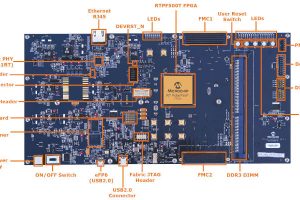East was CEO of Actel for 22 years.
“It’s been fun”, says East. But he also says: “Most of the fun has been had.”
Today, and for the rest of the week, we’re going to recapture some of the flavour of the industry remembered from East’s 42 years of chip-making.
Ham radio got him interested. By the time he was in High School he knew he wanted to be an electrical engineer and chose to study at the University of California at Berkeley graduating with a Master’s in September 1968. Fairchild was still the most exciting company in the industry and he applied for a job there.
“In May of 1968 I interviewed with Gene Flath (Operations), Tom Peardon (Production Control) and Jerry Briggs (HR),” remembers East, “I went to lunch, as I recall, with Briggs and Flath. They gave me a written offer. I was four months away from finishing my masters. They said to call a couple of days before I was ready to come and we would work out the details. I would be making the big bucks! $915/month.”
“I called Gene Flath immediately after taking my last final exam. A secretary answered the phone.
‘Gene who? I’ve never heard of Gene Flath,’ said the secretary, ‘there is no Gene Flath at Fairchild and has never been one as long as I’ve been here.’
‘How long have you been there?’
‘Three weeks.’
“I hung up and called Jerry Briggs.”
‘Jerry who? I’ve never heard of Jerry Briggs. There is no Jerry Briggs at Fairchild and there never has been one in all the time I’ve worked here.’
‘How long have you been there?’
‘I started last Tuesday.’
“But they all agreed on one thing, says East, ‘We’ve never heard of you. Are you sure you have the right company? There’s no job for you here.’
“Luckily I had the offer letter,” recalls East, “they honoured their commitment and gave me a job as a supervisor in a test area they called “wafer sort” and “class” (The same functions are called probe and final test nowadays.). My first boss, Les Faerber picked me up in the lobby and took me to the test area. Then he left to go to a meeting. I had no idea what all those people were doing in that test area. It was a mystery to me!”
“I had been at Fairchild about three months and showed up for work the day before Christmas expecting a normal work day. The operators (all women in those days) started showing up with food. A big pot-luck was set up right at the beginning of the 7am shift.”
“Technicians and engineers started showing up with things to drink. It looked like punch. It wasn’t. By noon everyone was a mess. I didn’t know what I was supposed to do about it. So …. I did nothing. There were hardly any wafers sorted that day which was a lucky thing. We would only have messed them up.”
“On Monday morning a letter came out from the top guy in the personnel department. “It’s been called to our attention etc etc. Further episodes will result in dismissal’.”
Fortunately, East avoided further episodes. “I became a product engineer in January of 1969,” he remember, “on the first nice spring day the older engineers (they were probably 26 years old or so) decided to go to Rosati’s for lunch. They invited me.
I was working on a problem in wafer sort. I told the operator that I’d finish up when I came back.”
“She said: ‘Back? You’re not coming back’.”
‘Yes I am. Of course I am.’
‘No you’re not!’
“She was right.”
“Rosati’s was in the hills not too far from Stanford. It had long wooden tables. Lots of kegs of beer. Hamburger, fries. A pitcher of beer. Another pitcher of beer. Another pitcher of beer. Everyone wasted. Nobody went back,” remembers East.
“My wife of a few months almost had a heart attack when I told her about it. ‘You’re going to get fired!!’ But …. That’s what they did in those days.”
“Fairchild had been losing money. As I look back on it, I imagine they might have been in a severe cash problem. One day Les Hogan (CEO) was interviewed by someone in the press.
‘What are you going to do to stem the losses?’
‘Not a problem. We’re going to reduce the headcount by a third. That will get our spending back in line.’
“That quote made the front page of the business section of the local newspaper.,” recalls East, “it probably felt good to the investors when they read it, but felt really bad to the people who worked there.’
“That was the beginning of some serious layoffs.” It also led to some serious criticism from Fairchild’s severest critic, Don Hoefler.
“I never met Don Hoefler,” reminisces East, ” I think he had worked a Fairchild at one time and that there was bad blood when he left. He started writing a weekly industry newsletter. It was always very negative towards Fairchild. Needless to say the upper echelon at Fairchild were not enamoured of Hoefler. I heard several times that anyone caught in possession of one of Hoefler’s newsletters was subject to being fired but that might have been just a rumour.”
“Don Hoefler’s newsletter on ‘Layoffs Fairchild style’ described how Fairchild employs three unique tactics for implementing lay-offs. The paging system layoff, the locked door layoff, and the retroactive layoff.”
“It seemed like every other Friday somewhere in Fairchild there were layoffs,” recounts East, “everyone would go straight to the cafeteria Friday mornings. No one even bothered going to their desk. Everybody was scared to death. Everybody needed their job and knew that there was a very good chance that they would lose it in the next 15 minutes. Lots of gallows humor. Lots of camaraderie. Everybody loved everybody else. There are no atheists in foxholes.”
- The Paging System Lay-off.
“There was a paging system in the building,” recalls East, “around 9am the paging system would crank up. ‘Bob Martin 2867’ . Everybody knew what that meant. Bob Martin (who was a real person and a really delightful guy knew what it meant too. Bob would stand up and start shaking hands. After he said goodbye to everyone, he’d walk over to the phone and call 2867. 2867 was, of course, the HR department (Called “personnel” in those days). ‘Bob, this is Bill, can you drop by to see me?’ That would be the last that anyone would ever see or hear of Bob Martin.”
2. The Locked Door Layoff
“This one never made much sense to me,” says East, “but Hoefler swore it happened.
There was great fear in those days that company secrets would be stolen by people leaving the company (The Basic Data Handbook was the result of a lot of work that Fairchild rightly didn’t want to fall into the hands of the startups who were trying to eat Fairchild’s lunch).”
“According to Hoefler, if you were going to lay off someone in possession of a lot of key knowledge, then the way to do it was to have the facilities department change the lock on the victim’s door at night. Then, when the victim arrived in the morning and found his key wouldn’t open the door, he’d go see his boss who would then lay him off. That way he had no pre-warning and couldn’t sneak the key information out before the axe fell.”
3. The Retroactive Layoff
“This happened if you were unlucky enough to be selected for downsizing when you were out on vacation,” remembers East, “when the victim returned he was informed that he had been laid off and that there was good news and bad news:
‘The good news is we gave you two weeks of severance pay.’
‘The bad news is you were laid off two weeks ago’.”
Tomorrow: How Wilf Corrigan made his numbers
 Electronics Weekly Electronics Design & Components Tech News
Electronics Weekly Electronics Design & Components Tech News



